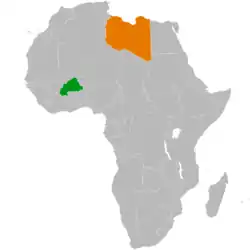Burkina Faso–Libya relations
Burkina Faso–Libya relations refers to the current and historical relationship between State of Libya and the Republic of Burkina Faso. Libya maintains an embassy in the Burkinabé capital of Ouagadougou, and Burkina Faso one in the Libyan capital of Tripoli.
 | |
Burkina Faso |
Libya |
|---|---|
History
In October 1982, only a month before being overthrown, the Burkinabé military ruler Colonel Saye Zerbo made a state visit to Tripoli.[1]
Relations between the Libyan leader Muammar Gaddafi and the government of Thomas Sankara, a Burkinabé Marxist and pan-Africanist, were initially close after Sankara came to power in a military coup in 1983. Prior to the coup, Burkina Faso was known as the Republic of Upper Volta and Sankara, as Prime Minister under the rule of Major Dr. Jean-Baptiste Ouédraogo, invited Gaddafi to Ouagadougou. Gaddafi, intrigued by Sankara, met only with the young revolutionary-minded officer and not with President Ouédraogo, reportedly causing significant friction between Sankara and his then-superior. This is presumed to have contributed to the reasons behind Sankara's imprisonment by Ouédraogo, which eventually helped trigger the Sankara-led military coup that ousted Ouédraogo.[2] On 6 August 1983, only two days after the coup, Gaddafi sent an air plane full of aid to the new government – Sankara, however, asked the Libyans to stop sending it. In December that year Gaddafi made another visit to Ouagadougou, accompanied by 450 bodyguards.[1]
Strong relations with Sankara's newly renamed Burkina Faso, which he attempted to radically transform through what he dubbed the "Democratic and Popular Revolution" (French: Révolution démocratique et populaire), fit squarely into Gaddafi's plans to extend Libyan influence into sub-Saharan Africa. Economically, the value of the international trade between the two countries was low however, and remains so to this day.[1] In October 1985 Sankara reciprocated Gaddafi's visits by meeting with him in Tripoli, after returning from a visit to Moscow.[3]
Despite the early close ties, the relation between Sankara and Gaddafi eventually deteriorated. On 15 October 1987, Sankara's former friend and colleague Blaise Compaoré launched another military coup, killing Sankara and making himself President. According to some reports, the coup was at least partially engineered by the Liberian Charles Taylor, at the time a close ally of the Gaddafi regime.[4] Compaoré had previously during the 1980s ensured Taylor's release when he was held in a Ghanaian prison, and introduced Taylor to Gaddafi.[5]
Libya made an effort to re-establish close cooperation, with a number of state visits following the coup. By 1988, relations were even better than during Sankara's heyday.[6] Despite Libya's status as a pariah state, Compaoré would remain a close Libyan ally, visiting Tripoli a number of times, condemning United States air strikes against Libya, maintaining close military cooperation, and establishing the joint Banque Arab-Libyenne du Burkina. Acting as a middle man for Libya, Burkina Faso became heavily involved in the First Liberian Civil War and the Sierra Leone Civil War, sending arms and deploying troops in favour of Charles Taylor's National Patriotic Front of Liberia.[5][6]
A sign of the close Burkinabé–Libyan relations at the turn of the millennium was the creation of the Community of Sahel-Saharan States, which both countries were founding members of.[6] Relations became far more complicated in the 21st century, when the 2011 Libyan Civil War broke out. On 24 August 2011, after the fall of Tripoli to rebel hands, Burkina Faso announced that it had stopped recognizing the Great Socialist People's Libyan Arab Jamahiriya, and instead recognized the rival National Transitional Council. Despite this, the country initially extended an offer of asylum to Gaddafi, even though it was a signatory of the International Criminal Court, which had charged the Libyan leader with crimes against humanity.[7] The offer was later withdrawn on 7 September.[8] Muammar Gaddafi was captured and killed on 20 October 2011.
Three years later, the turn came to President Blaise Compaoré to be overthrown. The 2014 Burkinabé uprising broke out in late October 2014, eventually forcing Compaoré to resign and flee the country. Likewise forced to leave his position was Yéro Boly, Minister of Defence since 2004 and the Burkinabé ambassador to Libya between 1988 and 1995. On the first day of the uprising, a protester in Bobo Dioulasso pulled down a statue of Compaoré – notably leaving an adjacent statue of the Gaddafi, erected in the mid-1990s, intact.[9]
A sign of the cultural exchange between Burkina Faso and Libya during the Gaddafi era is the involvement of Burkinabé football players in Libyan sports – among them Harouna Bamogo, Pierre Koulibaly, and Paul Koulibaly.
See also
References
- Rupley, Lawrence; Bangali, Lamissa; Diamitani, Boureima (2013). Historical Dictionary of Burkina Faso. Lanham: Scarecrow Press. p. 124. ISBN 081-088-010-5.
- Manson, Katrina; Knight, James (2012). Burkina Faso. Chalfont St Peter: Bradt Travel Guides. p. 27. ISBN 184-162-352-0.
- "Burkina Faso Leader Visits Moscow, Tripoli". Los Angeles Times. Los Angeles. 16 October 1986. Retrieved 4 November 2014.
- Kasuka, Bridgette (2013). Prominent African Leaders Since Independence. Intercontinental Books. p. 302. ISBN 998-716-026-3.
- Adebajo, Adekeye (2002). Liberia's Civil War: Nigeria, ECOMOG, and Regional Security in West Africa. Boulder: Lynne Rienner Publishers. p. 55. ISBN 158-826-052-6.
- Welz, Martin (2012). Integrating Africa: Decolonization's Legacies, Sovereignty and the African Union. London: Routledge. p. 111. ISBN 041-552-201-3.
- Lewis, David (24 August 2011). "Burkina Faso offers Gaddafi exile". Reuters. Retrieved 4 November 2014.
- "Burkina Faso does not want Gaddafi". The Africa Report. 7 September 2014. Retrieved 4 November 2014.
- Penney, Joe; Bonkoungou, Mathieu (28 October 2014). "Clashes at Burkina Faso protest against leader's plan to extend rule". Reuters. Retrieved 4 November 2014.